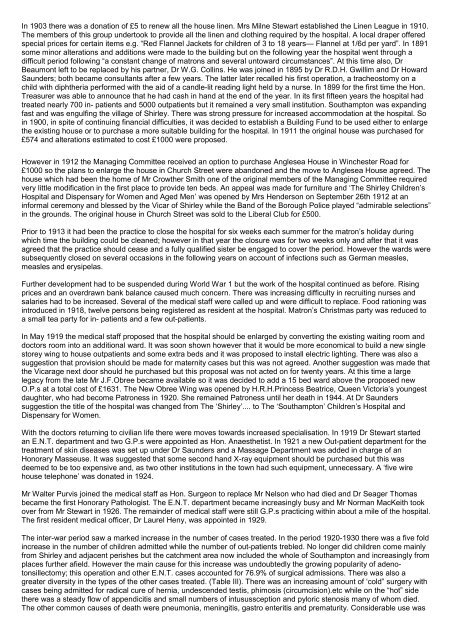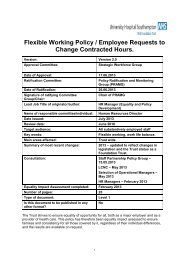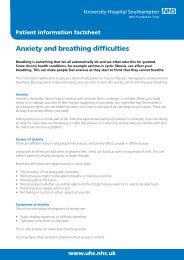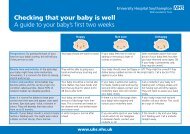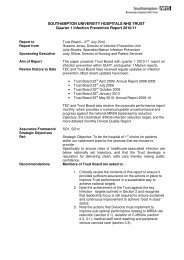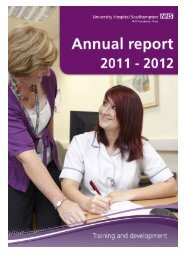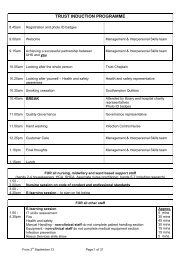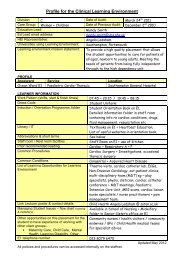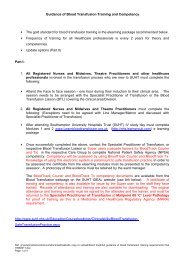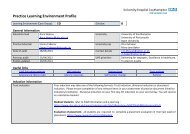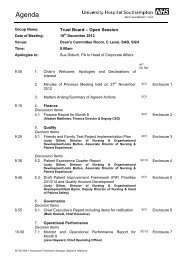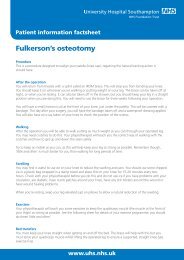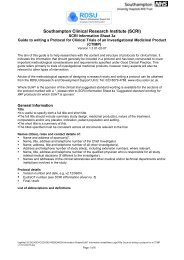ninety years of service - University Hospital Southampton NHS ...
ninety years of service - University Hospital Southampton NHS ...
ninety years of service - University Hospital Southampton NHS ...
- No tags were found...
Create successful ePaper yourself
Turn your PDF publications into a flip-book with our unique Google optimized e-Paper software.
In 1903 there was a donation <strong>of</strong> £5 to renew all the house linen. Mrs Milne Stewart established the Linen League in 1910.The members <strong>of</strong> this group undertook to provide all the linen and clothing required by the hospital. A local draper <strong>of</strong>feredspecial prices for certain items e.g. “Red Flannel Jackets for children <strong>of</strong> 3 to 18 <strong>years</strong>— Flannel at 1/6d per yard”. In 1891some minor alterations and additions were made to the building but on the following year the hospital went through adifficult period following “a constant change <strong>of</strong> matrons and several untoward circumstances”. At this time also, DrBeaumont left to be replaced by his partner, Dr W.G. Collins. He was joined in 1895 by Dr R.D.H. Gwillim and Dr HowardSaunders; both became consultants after a few <strong>years</strong>. The latter later recalled his first operation, a tracheostomy on achild with diphtheria performed with the aid <strong>of</strong> a candle-lit reading light held by a nurse. In 1899 for the first time the Hon.Treasurer was able to announce that he had cash in hand at the end <strong>of</strong> the year. In its first fifteen <strong>years</strong> the hospital hadtreated nearly 700 in- patients and 5000 outpatients but it remained a very small institution. <strong>Southampton</strong> was expandingfast and was engulfing the village <strong>of</strong> Shirley. There was strong pressure for increased accommodation at the hospital. Soin 1900, in spite <strong>of</strong> continuing financial difficulties, it was decided to establish a Building Fund to be used either to enlargethe existing house or to purchase a more suitable building for the hospital. In 1911 the original house was purchased for£574 and alterations estimated to cost £1000 were proposed.However in 1912 the Managing Committee received an option to purchase Anglesea House in Winchester Road for£1000 so the plans to enlarge the house in Church Street were abandoned and the move to Anglesea House agreed. Thehouse which had been the home <strong>of</strong> Mr Crowther Smith one <strong>of</strong> the original members <strong>of</strong> the Managing Committee requiredvery little modification in the first place to provide ten beds. An appeal was made for furniture and ‘The Shirley Children’s<strong>Hospital</strong> and Dispensary for Women and Aged Men’ was opened by Mrs Henderson on September 26th 1912 at aninformal ceremony and blessed by the Vicar <strong>of</strong> Shirley while the Band <strong>of</strong> the Borough Police played “admirable selections”in the grounds. The original house in Church Street was sold to the Liberal Club for £500.Prior to 1913 it had been the practice to close the hospital for six weeks each summer for the matron’s holiday duringwhich time the building could be cleaned; however in that year the closure was for two weeks only and after that it wasagreed that the practice should cease and a fully qualified sister be engaged to cover the period. However the wards weresubsequently closed on several occasions in the following <strong>years</strong> on account <strong>of</strong> infections such as German measles,measles and erysipelas.Further development had to be suspended during World War 1 but the work <strong>of</strong> the hospital continued as before. Risingprices and an overdrawn bank balance caused much concern. There was increasing difficulty in recruiting nurses andsalaries had to be increased. Several <strong>of</strong> the medical staff were called up and were difficult to replace. Food rationing wasintroduced in 1918, twelve persons being registered as resident at the hospital. Matron’s Christmas party was reduced toa small tea party for in- patients and a few out-patients.In May 1919 the medical staff proposed that the hospital should be enlarged by converting the existing waiting room anddoctors room into an additional ward. It was soon shown however that it would be more economical to build a new singlestorey wing to house outpatients and some extra beds and it was proposed to install electric lighting. There was also asuggestion that provision should be made for maternity cases but this was not agreed. Another suggestion was made thatthe Vicarage next door should he purchased but this proposal was not acted on for twenty <strong>years</strong>. At this time a largelegacy from the late Mr J.F.Obree became available so it was decided to add a 15 bed ward above the proposed newO.P.s at a total cost <strong>of</strong> £1631. The New Obree Wing was opened by H.R.H.Princess Beatrice, Queen Victoria’s youngestdaughter, who had become Patroness in 1920. She remained Patroness until her death in 1944. At Dr Saunderssuggestion the title <strong>of</strong> the hospital was changed from The ‘Shirley’.... to The ‘<strong>Southampton</strong>’ Children’s <strong>Hospital</strong> andDispensary for Women.With the doctors returning to civilian life there were moves towards increased specialisation. In 1919 Dr Stewart startedan E.N.T. department and two G.P.s were appointed as Hon. Anaesthetist. In 1921 a new Out-patient department for thetreatment <strong>of</strong> skin diseases was set up under Dr Saunders and a Massage Department was added in charge <strong>of</strong> anHonorary Masseuse. It was suggested that some second hand X-ray equipment should be purchased but this wasdeemed to be too expensive and, as two other institutions in the town had such equipment, unnecessary. A ‘five wirehouse telephone’ was donated in 1924.Mr Walter Purvis joined the medical staff as Hon. Surgeon to replace Mr Nelson who had died and Dr Seager Thomasbecame the first Honorary Pathologist. The E.N.T. department became increasingly busy and Mr Norman MacKeith tookover from Mr Stewart in 1926. The remainder <strong>of</strong> medical staff were still G.P.s practicing within about a mile <strong>of</strong> the hospital.The first resident medical <strong>of</strong>ficer, Dr Laurel Heny, was appointed in 1929.The inter-war period saw a marked increase in the number <strong>of</strong> cases treated. In the period 1920-1930 there was a five foldincrease in the number <strong>of</strong> children admitted while the number <strong>of</strong> out-patients trebled. No longer did children come mainlyfrom Shirley and adjacent perishes but the catchment area now included the whole <strong>of</strong> <strong>Southampton</strong> and increasingly fromplaces further afield. However the main cause for this increase was undoubtedly the growing popularity <strong>of</strong> adenotonsillectomy;this operation and other E.N.T. cases accounted for 76.9% <strong>of</strong> surgical admissions. There was also agreater diversity in the types <strong>of</strong> the other cases treated. (Table IIl). There was an increasing amount <strong>of</strong> ‘cold” surgery withcases being admitted for radical cure <strong>of</strong> hernia, undescended testis, phimosis (circumcision).etc while on the “hot” sidethere was a steady flow <strong>of</strong> appendicitis and small numbers <strong>of</strong> intusussception and pyloric stenosis many <strong>of</strong> whom died.The other common causes <strong>of</strong> death were pneumonia, meningitis, gastro enteritis and prematurity. Considerable use was


